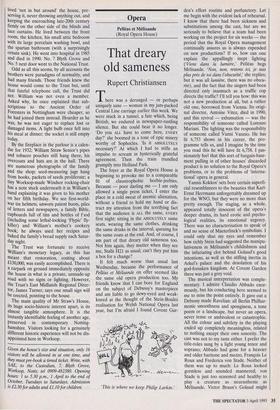ARTS
Heritage
A house in aspic
John Henshall
Mr Straw's House (Worksop, Notts) In December 1990, the National Trust received a telephone call from a solicitor in Gainsborough, telling them they had been left a semi-detached, three-storey house at Worksop, and nearly £1.5 million in other property, stocks and shares. Naturally the Trust was delighted, though their emphasis today is on acquiring countryside and coastline; so a small suburban semi? When Simon Murray, the Trust's Historic Build- ing representative, went to see No. 7, Blyth Grove, Worksop, it was originally with a view to deciding what should be kept or sold, and how to dispose of what he expect- ed would be an unremarkable building. This was not to be the case.
When he stepped inside Blyth Grove, Murray found he had entered a time-cap- sule of Twenties and Thirties life, with few concessions to more recent innovations. There was no radio, television, telephone, washing-machine or central heating. This was both a perfect example of a house from another age, packed with ephemera — let- ters, clothes, foodstuffs, drawers full of pic- tures, postcards and calling cards — and a shrine to its original owner, Worksop gro- cer and seed merchant, William Straw, originally of a family of potters from Sut- ton-in-Ashfield.
After William Straw died, in 1932, the house went into aspic. His sons, Walter and William, changed hardly anything down the years and threw almost nothing away. Wal- ter was in Worksop, helping run the family business, while William was pursuing an academic career in London. When their mother, Florence, died in 1939, William returned to Worksop, and for the next 40 years the brothers followed the same rou- tine: Walter cycled off each day to the shop in Market Square, while William kept house — hoarding, storing, annotating, and recording their provenance, with little notes stuck to chairs, pictures etc. There is a sense of this having been pre-planned.
It was William who was mainly responsi- ble for keeping modernity at bay: when Walter bought himself a car, William insist- ed he keep it at the shop, and Walter had to continue to cycle there daily. Walter died in 1976, and after that, as one Trust representative put it, it was as if William The front room, Mr Straw's House lived 'not in but around' the house, pre- serving it, never throwing anything out, and keeping the encroaching late-20th century firmly on the other side of the blinds and lace curtains. He lived between the front room, the kitchen, his small attic bedroom with its large porcelain washing bowl, and the spartan bathroom (with a surprisingly ornate sink). He went into hospital in 1985 and died in 1990. No. 7 Blyth Grove and No. 5 next door went to the National Trust.
Odd as all this seems, by all accounts the brothers were paradigms of normality, and had many friends. Those friends knew the house would come to the Trust but, until that fateful telephone call, the Trust did not. William was not even a member. Asked why, he once explained that sub- scriptions to the Ancient Order of Foresters in Nottingham were cheaper, so he had joined them instead. Hoarder as he was, he was not eager to replace lost or damaged items. A light bulb once fell into his meal at dinner; the socket is still empty today.
By the fireplace in the parlour is a calen- dar for 1932; William Straw Senior's pipes and tobacco pouches still hang there, his overcoats and hats are in the hall. There are numerous photographs of the family and the shop; seed-measuring jugs hang from hooks, packets of seeds proliferate; a tiny Worksop-made Windsor rocking-chair has a note stuck underneath it in William's hand explaining it was given to his mother on her fifth birthday. We see first-world- war tin helmets, unworn patent boots, piles of letters and newspapers, a family Bible, cupboards full of tins and bottles of hod (including some lethal-looking Tlypic' fly- killer) and William's mother's cookery book; he always used her recipes and baked the family's bread supply each Satur- day night.
The Trust was fortunate to receive William's monetary legacy, as this has meant that restoration, costing about £130,000, was easily accomplished. There is a carpark on ground immediately opposite the house in what is a private, unmade-up road with no signs or lighting. However, the Trust's East Midlands Regional Direc- tor, James Turner, says one small sign will be erected, pointing to the house.
The main quality of Mr Straw's House, its huge socio-historic interest apart, is its almost tangible atmosphere. It is the instantly identifiable feeling of another age, preserved in contemporary Notting- hamshire. Visitors looking for a genuinely different historic experience will not be dis- appointed here in Worksop.
Given the house's size and situation, only 16 visitors will be allowed in at one time, and they must pre-book a timed ticket. Write, with SAE, to the Custodian, 7, Blyth Grove, Worksop, Notts; tel 0909-482380. Opening hours: 1 to 5.30 p.m., 1 April to the end of October, Tuesdays to Saturdays. Admission is f2.30 for adults and f1.10 for children.



















































 Previous page
Previous page